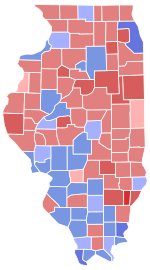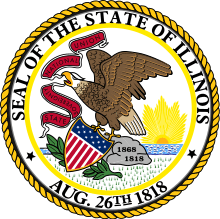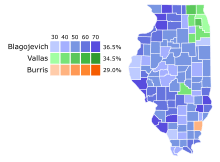2002 Illinois gubernatorial election
The 2002 Illinois gubernatorial election occurred on November 5, 2002. Incumbent Republican governor George Ryan, who was plagued by scandal, did not run for a second term. Democrat Rod Blagojevich, a U.S. Congressman, ran against Republican Jim Ryan (no relation to the incumbent), the Illinois Attorney General. Blagojevich won 52% to 45%, becoming the first Democratic governor of Illinois since 1972.
| ||||||||||||||||||||
| Turnout | 50.05% | |||||||||||||||||||
|---|---|---|---|---|---|---|---|---|---|---|---|---|---|---|---|---|---|---|---|---|
| ||||||||||||||||||||
 County results Blagojevich: 40–50% 50–60% 60–70% Ryan: 40–50% 50–60% 60–70% 70–80% | ||||||||||||||||||||
| ||||||||||||||||||||
| Elections in Illinois | ||||||||||
|---|---|---|---|---|---|---|---|---|---|---|
 | ||||||||||
|
||||||||||
|
||||||||||
|
||||||||||
Election information
The primaries and general elections coincided with those for federal elections (Senate and House), as well as those for other state offices. The election was part of the 2002 Illinois elections.
Democratic primaries
Governor
Candidates
- Rod Blagojevich, U.S. Representative
- Roland Burris, former Attorney General of Illinois, former Illinois State Comptroller, candidate for governor in 1994 and 1998 and independent candidate for Mayor of Chicago in 1995
- Paul Vallas, former CEO of Chicago Public Schools
Results
The Democratic primary was a very close 3-way race. Blagojevich prevailed by just 25,469 votes, and just by 2.03%. Vallas did very well in the Chicago suburbs, and narrowly defeated Burris in Cook County, the most populous county in the state. Vallas led early on in the night with Burris in second and Blagojevich in third. Vallas had won probably the most vital county, Cook County. For Blagojevich to beat both opponents, he had to run the board through the rest of Illinois. Blagojevich won almost all of the state's rural counties. Eventually, Cook County had reported all of its votes, with a slight advantage for Vallas over Burris. However many votes were still left to be counted in other cities outside the Chicago area. Blagojevich managed to pull out a narrow victory by winning in Champaign County, home of Champaign. Blagojevich also did well in Sangamon County home to the state's capital, Springfield. Blagojevich also won St. Clair County home of East St. Louis. In the early morning the day after the election, Vallas realized that with all of Cook County's votes counted he had lost. At 4:18 in the morning, Vallas called Blagojevich and congratulated him, and pledged Blagojevich his full support for the general election.

| Party | Candidate | Votes | % | |
|---|---|---|---|---|
| Democratic | Rod Blagojevich | 457,197 | 36.50 | |
| Democratic | Paul Vallas | 431,728 | 34.47 | |
| Democratic | Roland Burris | 363,591 | 29.03 | |
| Total votes | 1,252,516 | 100.00 | ||
Lieutenant governor
Candidates
- F. Michael Kelleher, Jr.
- Pat Quinn, former Treasurer of Illinois and candidate for Lieutenant Governor in 1998
- Joyce Washington
Results
| Party | Candidate | Votes | % | |
|---|---|---|---|---|
| Democratic | Pat Quinn | 471,038 | 42.11 | |
| Democratic | Joyce W. Washington | 362,902 | 32.35 | |
| Democratic | F. Michael Kelleher, Jr. | 284,549 | 25.44 | |
| Total votes | 1,118,489 | 100.00 | ||
Republican primary
Governor
Candidates
- Patrick O'Malley, State Senator
- Jim Ryan, Attorney General of Illinois
- Corrine Wood, Lieutenant Governor
Results
| Party | Candidate | Votes | % | |
|---|---|---|---|---|
| Republican | Jim Ryan | 410,074 | 44.68 | |
| Republican | Patrick O'Malley | 260,860 | 28.42 | |
| Republican | Corrine Wood | 246,825 | 26.89 | |
| Republican | Write-ins | 69 | 0.01 | |
| Total votes | 917,828 | 100.00 | ||
Lieutenant governor
Candidates
- Carl Hawkinson, former State Representative and Knox County State's Attorney
- Jack McInerney
- William O'Connor
- Charles Owens
Results
| Party | Candidate | Votes | % | |
|---|---|---|---|---|
| Republican | Carl Hawkinson | 373,040 | 47.22 | |
| Republican | William A. O'Connor | 257,375 | 32.58 | |
| Republican | Jack J. McInerney | 90,571 | 11.46 | |
| Republican | Charles G. Owens | 69,089 | 8.74 | |
| Total votes | 790,075 | 100.00 | ||
General election
Campaign
In the general election, Blagojevich defeated Republican Illinois Attorney General Jim Ryan by a solid margin. Ethics scandals had plagued the administration of incumbent Republican George Ryan, who was of no relation to Jim Ryan, and Blagojevich's campaign focused on the theme of "ending business as usual" in state government. During the campaign, Blagojevich played on the name of his opponent by asking "How can you replace one Ryan with another Ryan and call that change? You want change? Elect a guy named Blagojevich."[4]
Results
Although the election was thought to be a close one early on in the campaign, Blagojevich's big numbers out of Cook County were too much for the Republicans to come back from.
}}
| Party | Candidate | Votes | % | ± | |
|---|---|---|---|---|---|
| Democratic | Rod Blagojevich | 1,847,040 | 52.19% | +4.73% | |
| Republican | Jim Ryan | 1,594,961 | 45.07% | -5.96% | |
| Libertarian | Cal Skinner | 73,794 | 2.09% | N/A | |
| Independent | Marisellis Brown | 23,089 | 0.65% | N/A | |
| Write-in | Peter Dale Kauss | 8 | 0.00% | N/A | |
| Total votes | 3,538,891 | 100.00% | N/A | ||
| Democratic gain from Republican | |||||
See also
- Electoral history of Rod Blagojevich
References
- "Voter Turnout". www.elections.il.gov. Illinois State Board of Elections. Retrieved 24 March 2020.
- "Election Results". www.elections.il.gov. Illinois State Board of Elections. Retrieved 23 March 2020.
- "Ballots Cast". Illinois State Board of Elections. 19 March 2002. Retrieved 28 May 2019.
- Lin, Joanna (December 10, 2008). "He campaigned as a reformer". Los Angeles Times. Retrieved May 16, 2015.
- "Election Results". Illinois State Board of Elections. 5 November 2002. Retrieved 28 May 2019.

